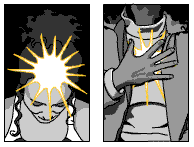The Church of E-Transcendental Beverages C of E (TB)
Created | Updated Jan 28, 2002


















A Church? Well why not
E, as in e-mail, etc.
Transendant Beverages, help the relaxed state - in moderation.


Please... enjoy... and read on

 Beer
Beer Orange
Orange Tea
Tea coffee
coffee Hotdog
Hotdog Burger
Burger

 Cake
Cake
 GOD'S WWW?
GOD'S WWW?

You have felt something like it too; In the mountains, by the sea, or perhaps while listening to a piece of music. In fact, many people report having had some sort of mystical or religious experience. For some, the experience is so intense it changes their life forever.

















So what is it? The presence of God? A glimpse of a higher plane of being? Or the mystical equivalent of deja vu, a trick the brain sometimes plays on your conscious self? Well at some level, of course, all our thoughts and sensations, however unusual, must involve the brain. Indeed, now, neuroscientists to suggest that the capacity for religion may somehow be hardwired into us.

















What are these sensations that are found to be unique to religious experiences, but - as one would expect from "universal hardware" - shared by people of all faiths? One of these is the sense of "oneness with the Universe". Another is the feeling of awe that accompanies such revelations and makes them stand out as more important, more highly charged, and in a way more real than our everyday lives.

















Rare, fleeting revelations are almost impossible to study. So leaving aside the one-off experiences that strike out of the blue, studies have focused on meditation and prayer that are reproducible.

















When volunteers meditated, focusing intently on a single image - usually a religious symbol - they felt their everyday sense of self begin to dissolve, so that they became one with the image. Feeling like a loss of boundary - as if the film of life broke - they were seeing the light that allowed the film to be projected.

















When the meditator felt the sense of oneness developing - usually after about an hour - they signalled the researchers to inject a radioactive tracer through an intravenous line. The tracer bound to the brain in greater amounts where the blood flow - and hence brain activity - was higher. Later a scanner measured the distribution of the tracer, yielding a snapshot of brain activity. The technique - (SPECT), Single Photon Emission Computed Tomography - allowed the subjects to meditate in relative peace. The activity of the subjects' brains during meditation was then compared with scans taken when they were simply at rest.

















Intense activity was found in the parts of the brain that regulate attention; a sign of the meditators' deep concentration. During meditation however, part of the parietal lobe, towards the top and rear of the brain, was much less active than when the volunteers were merely sitting still. This is was recognised as the exact region of the brain where the distinction between "Self" and "Other" originates.

















The left-hemisphere side of this region deals an individual's sense of their own body image. The right-hemisphere equivalent handles context in space and time inhabited by the self. As the meditators developed the feeling of oneness, they gradually cut these areas off from the usual touch and position signals that help create the body image - turning off their sensations to the outside world. Sights and sounds did not disturb them any more. That is why the parietal lobe got no input. Deprived, these regions no longer functioned normally. The boundary between self and other dissolved. And as the spatial and temporal context also disappeared, the person "felt" infinite space and eternity. Experiments with those whose prayer centred on words, not images; showed activation of the language areas of the brain. But they also shut down the same self-regions of the brain that the meditators did as their sense of oneness reached its peak.

















This sense of unity with the Universe is not the only characteristic of intense religious experiences. They also carry a hefty emotional charge, a feeling of awe and deep significance. Neuroscientists generally agree that this sensation originates in a region of the brain distinct from the parietal lobe - the limbic system, lying deep within the temporal lobes on the sides of the brain.
The limbic system is a part of the brain that dates from early in our evolution. Now it monitors experiences and labels especially significant events, such as a parent's sight of their child's face, with emotional tags to say, "This is important". During an intense religious experience, the limbic system becomes unusually active, tagging everything with special significance.

















This explains why people who have had such experiences find them so difficult to describe to others. The contents of the experience - the visual components, the sensory components - the temporolimbic system stamps as being intensely important to the individual - characterised by great joy and harmony. When the experience is reported to someone else, only the sense that it is different can be communicated.

















Plenty of evidence supports the idea that the limbic system is important in religious experiences. People who suffer epileptic seizures restricted to the limbic system, or the temporal lobes in general, sometimes report having profound experiences during their seizures. A sense of seeing through their superficial reality to a deeper reality. Indeed some theorised "epileptics" have historically great mystics. Similarly, stimulation of the limbic system during brain surgery is reported to produce "religious" sensations. On the other hand Alzheimer's disease, which is often marked by a loss of religious interest, tends to cripple the limbic system early on.

















The richness that limbic stimulation brings to experience may explain why religions rely so heavily on ritual. The deliberate, stylised ceremonies differentiates them from the everyday, helping the brain flag them as significant. Music effects the limbic system, driving it towards either arousal or serene bliss. Chanting or ritual movements do the same. Meditation has also been shown to induce both arousal and relaxation, often at the same time. Sometimes people refer to it as an active bliss.

















Now, it makes sense for God to design the hrain so that we can have some sort of interaction. The problem is that all of our experiences are equal, in that they are ALL in the brain. Our experience of reality, our experience of science, our mystical expericnces are all in the brain. The way we judge the reality of an experience is by how real it feels; a dream feels real at the time, but wake up and it no longer feels as real. When people have a mystical experience, they think, "that is more real than baseline reality" - even when they come back to baseline reality. That turns everything around. It means that reductionist science, powerful as it is, has its limitations.

















So our brains clearly allow a novel sort of experience that we call religion - and, (God's e-m communication system?), was hard wired into our evolution from an early stage. A technique called transcranial magnetic stimulation inciuces all sorts of surreal experiences in ordinary people. A weak magnetic, microtesla field, rotating anticlockwise in a complex pattern about the temporal lobes will cause four out ot five people to feel a spectral presence in the room with them, (turning on the system with a false signal?). What people make of that presence depends on their own biases and beliefs. Interestingly, this can be differentiated from a real mystical experience - as a dream is, later when awake - by those who have experienced both.


The above is true research material

 Cool Links
Cool Links

 Town MapDrinkies anyone?Peer ReviewMore about linksBBC Online
Town MapDrinkies anyone?Peer ReviewMore about linksBBC Online